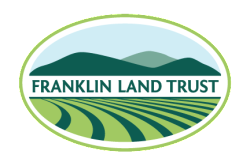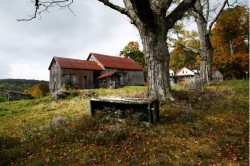This month’s post comes to us from dedicated members of The Franklin Trust (FLT) out of western Massachusetts — “a non-profit organization that assists farmers and other landowners who want to protect their land from unwanted development.” The NBA is pleased to the growing interest in land conservation as it relates to saving resources of all sorts — including the historic built environment!
 The people of Plainfield and of Western Massachusetts are privileged to have had the historic 107-acre Guyette Farm donated to the Franklin Land Trust. Under the supervision of the FLT, this land will be forever protected from development and neglect.
The people of Plainfield and of Western Massachusetts are privileged to have had the historic 107-acre Guyette Farm donated to the Franklin Land Trust. Under the supervision of the FLT, this land will be forever protected from development and neglect.
As a community leader in the protection of open land, the FLT is embarking on new ground with the recent acquisition of not just a beautiful piece of farmland, but also an entire farm complete with an antique barn. What is farmland without a farm or without a barn? Sometimes the proper stewardship of rural land involves the proper stewardship of the structures that defined that lands purpose in history.
The Guyette farm is home to an early 19th century English barn, not an average barn, but one full of unique architectural features not commonly found all in a single structure: The 30×40 foot barn is made up of large hand-hewed timbers, intricate English joinery, a steep roof, a five sided ridge beam and robust wind bracing in the roof system. This group of distinctive features defines this building as an early example of a classic English hinterland barn: the singular landscape element that symbolizes early American life.
Fortunately, for its age, this barn has survived with dignity: the core barn structure and even a small ell are in very good structural condition. The barn however is in jeopardy of structural failure and deterioration due to severe foundation issues. As is typical of structures built in the 1800’s, this barn, as strong as it is, was built on a rather poor stone foundation. Time and the cycling of the seasons have taken their toll on the stone structure supporting the barn and leave it struggling to stand straight. With foundation failure comes structural failure: something that is avoidable with proper and timely attention.
The Guyette barn is facing a critical time; it is a valued part of the Plainfield countryside and recognizable by generations of locals. To the casual observer it is a pastoral symbol of rural history quietly growing old in the field, but closer inspections reveals problems that will lead to its rapid decline if not addressed in the near future. This fine example of our agricultural heritage has a lot to offer and is capable of serving many more generations with proper stewardship. The Guyette barn is a barn worth saving and a project the Franklin Land Trust is privileged to have the opportunity to venture into.
If you want to help support the FLT in their effort to #savethatbarn, go to their webpage and make a contribution to the cause! http://www.franklinlandtrust.org/news/help-save-this-historic-barn
NBA thanks Mary Lynn Sabourin, Development Director of the FLT, for submitting this piece for posting on our blog, and the FLT, at large, for working hard to raise awareness of the cultural and historic value of the Guyette Barn and farmstead. To learn more about The Franklin Trust and their good works, visit: http://www.franklinlandtrust.org/

